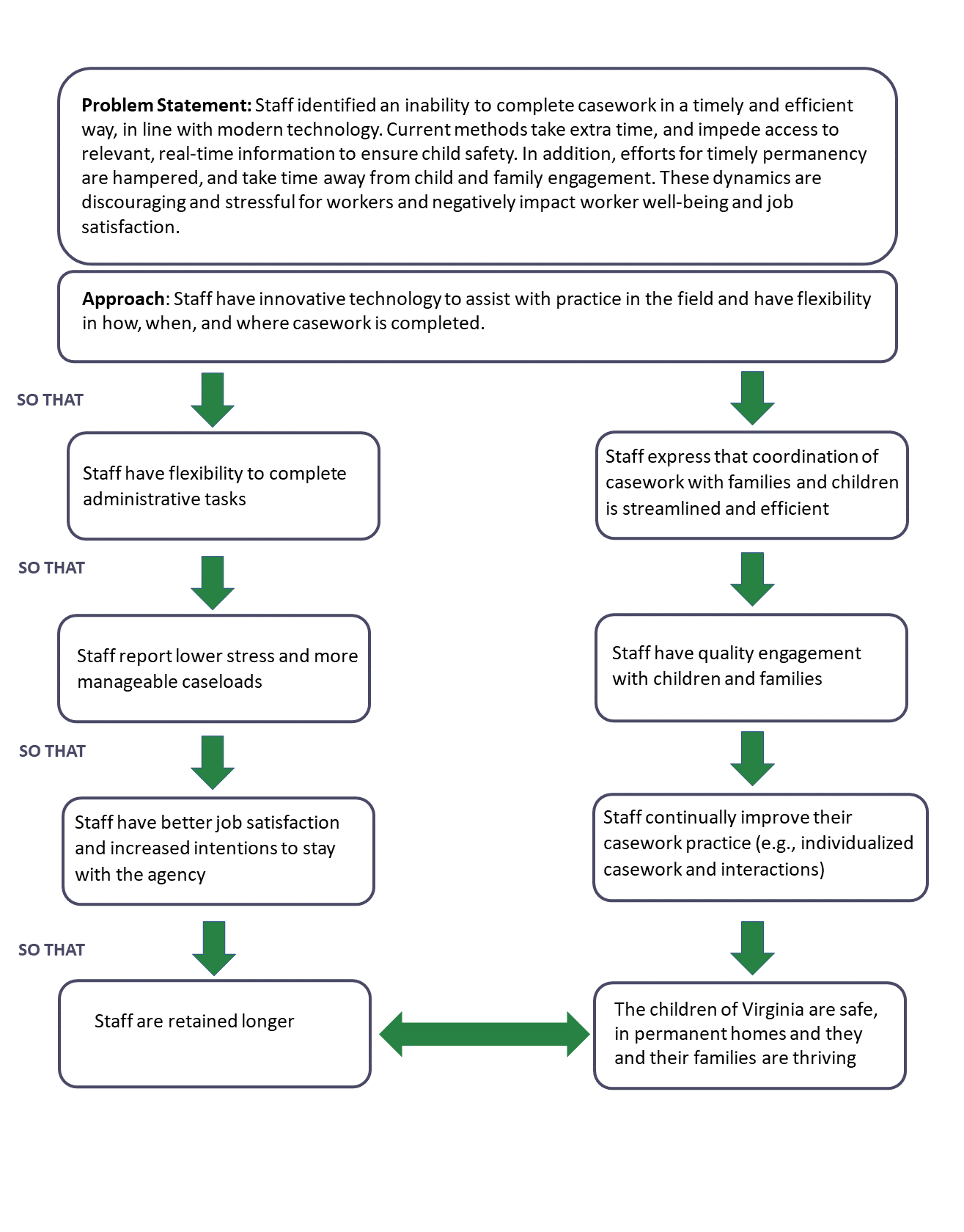Case-supportive Technology
During the needs assessment process, a theory of change was developed for the primary area of need identified in partnership with the Virginia Department of Social Services (VDSS). Through a series of steps and causal links, a theory of change provides a roadmap to address the root causes of an identified workforce problem and describes how and why changes are expected to lead to the desired outcomes. In Virginia, the theory was informed by the needs assessment process conducted by VDSS prior to the involvement of the Quality Improvement Center for Workforce Development (QIC-WD). They found that the biggest complaint among frontline workers and why they said they left the job was the lack of technological supports to help them complete job tasks more quickly. Thus, VDSS sought funding for and set in place two technological interventions: Transcription Services, which rolled out between November 2017 and January 2018, and Mobility, which rolled out between October 2019 and January 2020.
- Transcription: This service was devised to allow staff to phone a number and have a person with some familiarity with courts and child welfare casework type up case notes from visits with families, children and/or resource families or other case notes accomplished in the field with clients and collaterals. Because staff could call a number and verbally transmit information from the visit or meeting, this could be done right after a visit while driving back to the office, at home in the evening hours or in any setting, even the office.
- Mobility: Staff were given an iPad which had software loaded onto it that allowed staff to interface with their State Automated Child Welfare Information System (SACWIS), known in Virginia as OASIS, to modify demographics of members of cases, upload pictures and audiotaped sessions, upload case notes and other basic information for transfer to OASIS. A year later in April 2021, structured decision making (SDM) assessment tools were added to the software package. The purpose was to help staff save time in traveling to and from the office to complete desk tasks. The hope was that the saved time would allow staff to spend more time with families, children, and collaterals to enhance engagement.
The theory of change associated with the mobility intervention began with a problem statement. Staff identified an inability to complete casework in a timely and efficient way, in line with modern technology. Current methods took extra time, and impeded access to relevant, real-time information to ensure child safety. In addition, efforts for timely permanency were hampered, and took time away from child and family engagement. These dynamics were discouraging and stressful for workers and negatively impacted worker well-being and job satisfaction. The approach was for staff to have innovative technology to assist with practice in the field and have flexibility in how, when, and where casework was completed.
The hope was that 1) leaders in each locality would be fully engaged in seeing the advantages of the mobility application to enhance casework and help support staff in completing paperwork more efficiently and 2) that the application would save time for staff, especially as managers and supervisors allowed staff more flexibility in when and where their work got completed.
The theory of change notes that if staff have flexibility to complete administrative tasks, then staff will efficiently and accurately complete case documentation. Once documentation is completed then staff will report lower stress and a more manageable workload. Less stress will lead to greater staff job satisfaction and intent to stay with the agency. Intentions to stay with the agency (or not leave the agency) will in turn lead to greater retention of the child welfare workforce. In addition, the flexibility in completion of administrative tasks will lead to staff perceptions of casework with families and children to be more coordinated, streamlined, and efficient. This elevated efficiency will lead to greater quality engagement with children and families. Improved engagement will then contribute to continuous improvement of casework practice so that ultimately the children and families of Virginia are safe, in permanent homes, and thriving.
The following image depicts the theory of change beginning with a problem statement followed by a series of steps that lay out the logic on how that problem will be addressed.
